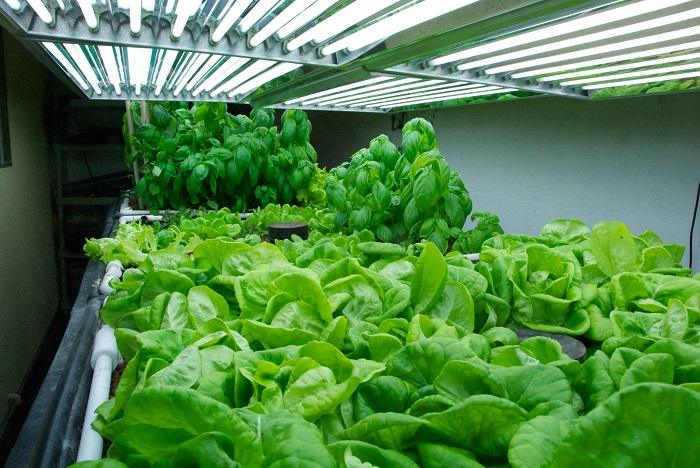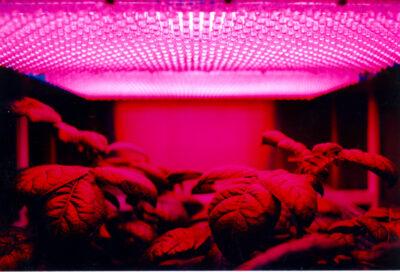Starting and growing plants indoors is a great way to augment your gardening space and to extend your growing season. However, providing the proper lighting for your indoor plants can seem like a daunting task.
It doesn’t have to be. With the right grow lights, you can be on your way to an indoor garden this winter. The first decision to make is incandescent versus fluorescent lighting. Most indoor plants will benefit from fluorescent lighting, which is more energy efficient and burns cooler than incandescent lighting.
Standard 20- and 40-watt fluorescent tubes are great for starting plants from seeds. For larger plants, you can use high output fluorescent lighting, which produces double the amount of light as standard tubes, yet burns cool. High output tubes have a lifespan of about 10,000 hours.
All Natural Fertilizer Doubles Garden Production!
Plants Need Light
Just as they do outdoors, plants have varying needs for light. Too much light can cause foliage to curl. Too much heat can cause leaves to burn. On the other hand, plants that receive too little light can become weak and stretched-out out or “leggy.”
How much light is the right amount depends on what you are growing. Foliage plants generally require less light, for instance, whereas exotic plants like more light. Keep in mind also that some plants – such as the poinsettia — require periods with no little to no light in order to flower.
Plants use light waves that we can see (visible light) and some invisible wavelengths we can’t see (such as infrared light). Plants capture these wavelengths in both the blue and red parts of the light spectrum to use during photosynthesis.
Standard incandescent lights serve as a good source of red rays, but they a poor source of blue rays. Incandescent bulbs also produce more heat than many plants can tolerate. On the other hand, fluorescent lights give off both red and blue wavelengths. They also give off little heat, so they can be placed only inches above seedlings and young plants.
Be sure to account for plant growth with the placement of your fluorescent grow lighting. Although fluorescent lights work well when they are close to plants, you will need to raise the fixtures as your plants grow. Plants that touch a fixture can burn, so consider adjustable hangers for your grow lights.
The Right Light to Garden Indoors
How do you determine how much indoor lighting you need? For light-needy plants like tomatoes, a good rule of thumb is about 40 watts per square foot of growing space. For low light plants such as herbs and lettuces, you need only about 25 to 30 watts per square foot.
When figuring your growing area, be sure to measure only your growing area, not the actual room size. If you will be growing tomatoes in a 3 x 3 area, here is the formula for lighting:
The growing area: 3 x 3 = 9 square feet. To get the desired wattage, multiply watts x square feet. So, 40 x 9 = 360 watts. You can round up to 400 watts and plan on using a 400 watt grow light for optimum tomato growth.
Also, consider a reflector. What is a reflector? A reflector ensures that your plants receive a uniform amount of light from a grow light.
Get The Best Deals On Non-GMO Heirloom Seeds Right Here!
Keep in mind that the quantity of light can drop off dramatically under the lights, depending on where the plants are located. A sign that this is happening is when seedlings and plants grow at an angle toward brighter light. To solve this problem, extend fluorescent light reflectors out past the edges of your flats. Another trick is to line older reflectors with aluminum foil to provide more light for your plants. You also can place aluminum foil or a white surface behind plant fixtures for more light reflection.
Horizontal reflectors are the most efficient reflectors and are the most popular. To determine the type of reflector you need, once again you must factor in the size of your growing area.
For the 3 x 3 tomato garden we have been using as an example, a small reflector will help provide the maximum amount of light on the growing plants. Look for reflectors that have air-cooling flanges and tempered glass.
Take the time to shop around for the right grow lights for your indoor garden. Check out your local garden store as well as some of the variety of deals that are available online.
About 2.7 million American households buy indoor grow lights each year and, according to the University of Vermont Extension Service, about 15 million American households grow plants under lights indoors. You can join those numbers today.
By using grow lights effectively, you can grow plants from virtually any location in your house at any time of year – and enjoy fresh produce even during the cold months. Give it a try.
 Off The Grid News Better Ideas For Off The Grid Living
Off The Grid News Better Ideas For Off The Grid Living





